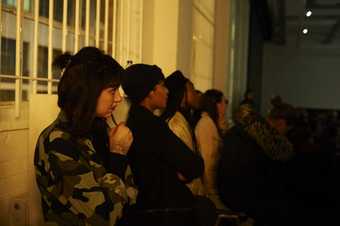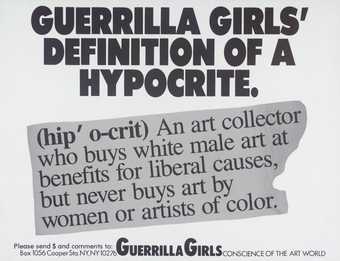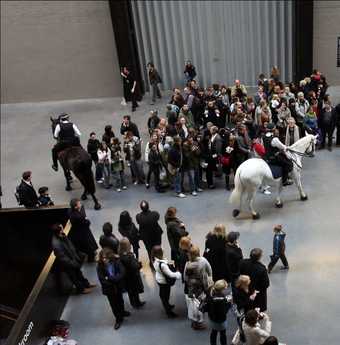HOW YOU CAN SUPPORT WOMEN IN ART THIS MONTH, ONLINE AND OFF
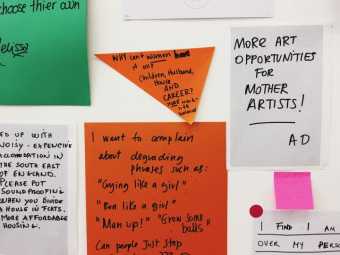
From the Guerrilla Girls Complaints Department at Tate Exchange, © Tate
MARCH IS WOMEN’S HISTORY MONTH. WHAT ARE YOU DOING TO RAISE VISIBILITY OF WOMEN IN THE ARTS, ONLINE AND OFF? READ ON FOR TATE’S TAKE ON DIVERSIFYING A COLLECTION, CREATING SPACES FOR DISCUSSION AND CELEBRATION, AND HOW YOU CAN TAKE MATTERS INTO YOUR OWN HANDS BY GOING EDIT-MODE ON WIKIPEDIA. GET STARTED WITH HOW-TOS, RESOURCES, AND TIPS ON HOW TO BEST TELL THE STORIES OF WOMEN ARTISTS ONLINE.
The number of women in the Tate collection is growing, and that’s a good thing. In the Blavatnik Building alone, which houses over 300 artists from more than 50 countries, half the rooms are devoted to a sole female artist.
Tate Modern Director Frances Morris, who has already curated three retrospectives of women in the gallery, has voiced her thoughts on how we can build upon and boost visibility of women artists in the collection. We can break away from the accepted canon of the art world (and market) in the 20th century, and look more closely at women artists who weren’t previously represented by traditional galleries. We can seek out those women doing challenging and innovative work who were otherwise rendered invisible by these structures, or named only as the wives and partners of male artists. And we can work towards greater representation of diverse, non-European women in the collection to keep it intersectional.
But where to begin? The history of women in art, as artists and otherwise, is a complex one. There’s no shortage of reading and watching on the subject. But here’s what you can do now to constructively celebrate women artists at Tate and beyond.
JOIN A SYMPOSIUM BY AND FOR WOMEN IN ART
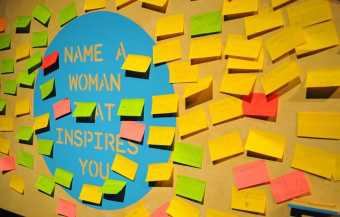
Superwoman, W Project for Tate Undercurrent Series Tank 2, August 2012
On March 7, the eve of International Women’s Day, join The W Project at Tate Exchange for a special edition symposiumexploring diversity in the art world and the future of curation. In their own words:
Our goal has been and continues to be the same – to shine a light on all the women the mainstream media doesn’t. Women who with their creativity and talent challenge the norm, break stereotypes and set the example every single day by doing what they believe in, unyieldingly. Strong, unapologetic and wild. Through this network of women that inspire us every day we understood that community spirit is the force that will help women artists claim their space and their place, continuously. We are proud to work alongside a growing group of diverse female creatives not only to celebrate and champion their work but most importantly to honour their perseverance.
The W Project will be sharing the floor with Frances Morris and a panel of women artists, creatives, and curators as they discuss how to build better creative communities for the future. While you’re there, have a look around Tate Exchange, a space for everyone to collaborate, test ideas and discover new perspectives on life, through art. Tate Exchange recently hosted the Guerrilla Girls, who combat racism and sexism in the art world and at large through their work. At Tate Exchange, they set up an in-gallery Complaints Department for anyone and everyone to air their grievances and share their thoughts on art, life, and anything else.
As you can see on their page, the Guerrilla Girls have been thoroughly written about on Wikipedia, and are highly visible across the online world. But what about artists who never got that visiblity, be that due to discrimination, negligence, or otherwise – where can we learn about, and preserve, their legacies and work? If we’re increasingly getting the majority of our information online, what happens to the women artists who don’t get digital coverage?
TELL THE STORIES OF WOMEN ARTISTS ON WIKIPEDIA
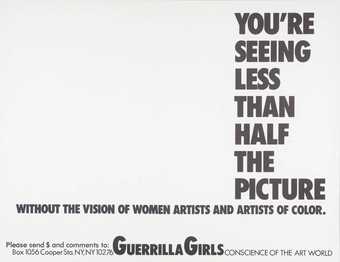
Guerrilla Girls
You’re Seeing Less Than Half The Picture (1989)
Tate
According to some surveys, only about 8.5-16 percent of Wikipedia editors identify as female. What does this have to do with representation of women in art? These figures matter because Wikipedia is a comprehensive reflection of our knowledge and the world we live in. Or at least it strives to be. But only one in five biographies on Wikipedia are about women, and while articles about women are highly likely to link to articles about men, the opposite simply isn’t true.
New female editors on Wikipedia are more likely than male editors to have their contributions altered or reverted. Add this to a lack of gender equality in the art world, where women account nearly half of all MFAs but less than a quarter of solo shows in New York, and it’s clear why we’re seeing less than half the picture.
There’s a persistent bias on Wikipedia. But so long as it’s open access and open source, the tools are in your hands to make a change for women and women artists on the platform. All you need is a log-in, some research and guidelines, and a drive to tell the stories of those history has overlooked. And what better way to celebrate Women’s History Month than that?
Tate hosted its own Wikipedia Edit-a-thon on March 4. Working together through a list of women artists from Tate’s collection who don’t have a Wikipedia page, or whose pages are insubstantial (or even just wrong), we worked to build online visibility for the women in Tate’s collection for generations to come.
Want to take Wikipedia editing into your own hands? We’ve pulled together a short guide on how to set up and write for Wikipedia with underrepresented women artists in mind. There’s a plethora of resources on how to edit Wikipedia out there, so get your editing hats on and let’s build up the stories of artists in the Tate collection and beyond.
GETTING STARTED ON WIKIPEDIA
- Know what you’re working with. Take a moment to wrap your head around Wikipedia and how it works. Understand that Wikipedia is a self-revising community and a living encyclopaedia, written by hundreds of thousands of individuals from around the world.
- Create a profile. Anyone with an account on Wikipedia can create and make edits to existing pages. So create a profile for yourself. You wield real power in the Wiki world now – use it wisely.
- Familiarise yourself with Wikipedia’s suite of editing tools. Wikipedia has its own guide, or you could head over to Art + Feminism’s short video guides for a rundown of what’s available.
WRITING, RESEARCHING, AND REVISING
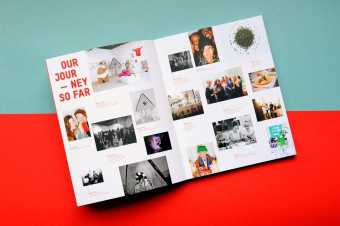
W Project, Journey Is The Treasure, self published book project, 2013
- Identify someone whose bio needs work. Don’t know where to begin? Take a look at Tate’s artists and see whose bios are incomplete, lacking, or non-existent. How about Teresa Margolles? Or Amelia Long? Or here’s a more comprehensive worklist of women artists who have been identified as needing work.
- Need inspiration? If you’re not familiar with Wikipedia’s biography structure and style, take a look at what already exists. Particularly well-done articles about women artists are here.
- Do your research. Wikipedia runs on references, citations, and published knowledge. Start digging! Seek out books and other published resources to get the facts.
- Visit the Tate Library, where you can find art books and many other specialist materials. Check out other resources and databases on women artists, such as the Clara Database or the Women’s Art Library.
- And get writing!
TIPS
- When writing, speak from a neutral point of view. Avoid stating opinions as facts (and vice versa)
- Remember that every edit you make is visible, and traces back to your account. This allows revision and dialogue with other Wikipedia users, and keeps you accountable
- You can’t write about yourself
- Avoid writing about anything or anyone where there’s an obvious conflict of interest
- Always cite your sources
- Wikipedia content must be notable. A notable topic should have a body of scholarship or coverage behind it. This is a good principle to keep in mind, but particularly when writing about underrepresented artists, you should think about how the idea of notability might lend itself to structural sexism, racism, or discrimination by rendering certain people or groups historically invisible
- Keep in mind the Finkbeiner test. This is a checklist proposed to help journalists avoid gender bias in articles about women scientists, but it can be useful when writing about women in any field. It can help keep someone’s merits and contributions as the focus without unconsciously presenting their gender their most defining quality
MORE RESOURCES
- For a general manual of style for biographies, click here
- Check out existing initiatives like Art + Feminism, a collective of editors and volunteers coordination edit-a-thons around the world seeking to increase coverage of women in the arts. WikiProject Women Artists also builds visibility for women artists online. Or get offline and find an event near you
- When in doubt, consult the Teahouse, a friendly forum for learning about how to edit on Wikipedia
JOIN THE CONVERSATION AROUND WOMEN IN ART
Share your stories around women in art: tell #TateExchange what you would do to support women artists.
Have an answer? Tell us on Quora. Explore how women have been represented, underrepresented, and misrepresented in art history and tell us how we can write women back into art history.


